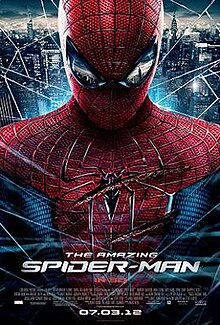| The Amazing Spider-Man | |
|---|---|
 Theatrical release poster | |
| Directed by | Marc Webb |
| Screenplay by | |
| Story by | James Vanderbilt |
| Based on | |
| Produced by | |
| Starring | |
| Cinematography | John Schwartzman |
| Edited by | |
| Music by | James Horner |
Production companies |
|
| Distributed by | Sony Pictures Releasing |
Release dates |
|
Running time | 136 minutes[2] |
| Country | United States |
| Language | English |
| Budget | $200–230 million[a] |
| Box office | $758 million[6] |
The Amazing Spider-Man is a 2012 American superhero film based on the Marvel Comics character Spider-Man which shares the title of the longest-running Spider-Man comic book series. It was produced by Columbia Pictures in association with Marvel Entertainment, Laura Ziskin Productions, Arad Productions, Inc., and Matt Tolmach Productions, and distributed by Sony Pictures Releasing. It is the fourth theatrical Spider-Man film, serving as a reboot following Sam Raimi's 2002–2007 Spider-Man trilogy, and was followed by a second The Amazing Spider-Man film. The film was directed by Marc Webb and written by James Vanderbilt, Alvin Sargent, and Steve Kloves, based on a story by Vanderbilt, and stars Andrew Garfield as Peter Parker / Spider-Man alongside Emma Stone, Rhys Ifans, Denis Leary, Campbell Scott, Irrfan Khan, Martin Sheen, and Sally Field. Teenager Peter Parker gains spider-like powers and fights crime as Spider-Man, attempting to balance heroics with his ordinary life.
Development of the film began following the cancellation of Spider-Man 4 in January 2010, ending director Sam Raimi's Spider-Man series that starred Tobey Maguire. Columbia Pictures opted to reboot the franchise with the same production team, with Vanderbilt staying on to write, and Sargent and Kloves helping with the script. The main characters were cast in 2010, during pre-production. New designs were introduced from the comics, such as artificial web-shooters. Using Red Digital Cinema Camera Company's RED Epic camera, principal photography started in December 2010 in Los Angeles before moving to New York City. The film entered post-production in April 2011. 3ality Technica provided 3D image processing, while Sony Pictures Imageworks handled CGI effects. It was the last American film scored by James Horner to be released before his death in 2015, and the penultimate film for producer Laura Ziskin, who died in 2011.
Sony Pictures Entertainment built a promotional website, releasing many previews and launching a viral marketing campaign; tie-ins included a video game by Beenox and Activision. The film premiered in Tokyo on June 30, 2012, and was released in 2D, 3D, IMAX 3D, and 4DX formats in the United States on July 3, ten years after the release of Spider-Man (2002). It received positive reviews from critics, who praised its performances, the chemistry between Stone and Garfield, direction, action sequences, visual effects, and musical score, while its plot elements drew some criticism. The film was the seventh-highest-grossing film of 2012, taking in $758 million worldwide. A sequel, The Amazing Spider-Man 2, was released on May 2, 2014. In 2021, Garfield and Ifans reprised their roles in the MCU film Spider-Man: No Way Home, which dealt with the concept of the multiverse and linked that franchise to the Raimi and Webb installments.
- ^ Cite error: The named reference
thr-reviewwas invoked but never defined (see the help page). - ^ "The Amazing Spider-Man". British Board of Film Classification. August 8, 2012. Archived from the original on June 30, 2012. Retrieved August 10, 2012.
- ^ Dodes, Rachel (June 29, 2012). "Spinning a Tangled Web—Again". The Wall Street Journal. Archived from the original on December 24, 2018. Retrieved July 12, 2012.
- ^ Grover, Ronald; Richwine, Lisa (May 29, 2012). "Sony's big summer bet starts strong with "MIB 3" debut". Reuters. Archived from the original on October 22, 2019. Retrieved July 27, 2012.
- ^ Graser, Marc (June 27, 2012). "Spider-Man campaign aims to snare femmes". Variety. Retrieved July 27, 2012.
- ^ a b "The Amazing Spider-Man (2012)". Box Office Mojo. Archived from the original on July 16, 2012. Retrieved July 16, 2012.
- ^ Horn, John (June 20, 2012). "Sony's new 'Spider-Man' poised for amazing opening". Los Angeles Times. Archived from the original on November 24, 2012. Retrieved July 6, 2012.
Cite error: There are <ref group=lower-alpha> tags or {{efn}} templates on this page, but the references will not show without a {{reflist|group=lower-alpha}} template or {{notelist}} template (see the help page).